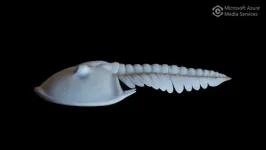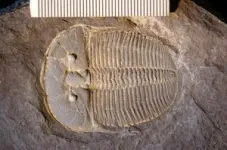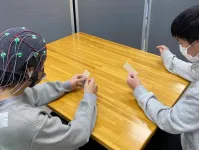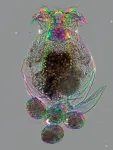(Press-News.org) Scientists have worked out how one unusual species of trilobite — an ancient, sea-dwelling relative of spiders and lobsters — was able to defend itself against predators and survive a bumpy ride as Earth’s oxygen levels fluctuated.
The seas were filled with trilobites for nearly 300 million years starting in the Cambrian Period, some 520 million years ago. During their time on Earth, which lasted much longer than the dinosaurs, they survived two major episodes of mass extinctions and dominated ocean floor ecosystems.
Their armored bodies are divided into three sections: a head, a thorax or middle section, and a rigid tail. There are more than 20,000 known trilobite species and, when mature, most of them have a very specific number of segments in their mid-sections. However, in Aulacopleura koninckii, scientists discovered something unusual.
Though each early growth stage showed little variation in size and shape, mature Aulacopleura developed anywhere between 18 and 22 mid-section segments.
“My collaborators and I thought this species was weird. We couldn’t understand why Aulacopleura bodies varied and others living at the same time had a constant number,” said Nigel Hughes, UC Riverside paleobiologist and corresponding author of a new study about this trilobite.
“Seeing trilobites with variable numbers of segments in the thorax is like seeing humans born with different numbers of vertebrae in their backs,” Hughes said.
The researchers had questions about this anomaly, how it affected the animals’ ability to protect itself, and why it might have developed in this way. These questions are answered in a new study published in the Proceedings of the Royal Society B: Biological Sciences.
Like modern pillbugs or “rollie pollies,” trilobites curled up into a ball shape to protect themselves from large squid-like creatures, fish, and other predators. When rolled up, they could tuck their tails neatly under their heads, so the soft tissues were protected by their hard exterior skeletons. In the case of Aulacopleura, 3D modelling showed that protection during rolling up was restricted to smaller, immature forms with less than 18 segments in the middle.
“As the number of segments increased, the body proportions did not allow them to tuck their posteriors neatly under their heads and still be completely shielded,” Hughes said. “So, why did this species keep adding segments anyway, and how could it survive the nasty predators?”
Based on their virtual reconstructions, it seems highly likely that when Aulacopleura with a large number of mid-segments felt threatened, they would roll up like their relatives and simply let their tails extend past their heads, minimizing the exposed gap.
“Other possible defense maneuvers would have left gaps on the sides that exposed critical organs — highly unlikely,” Hughes said.
As to the question of why this trilobite varied in the number of mid-section segments, the researchers turned to their earlier work. “What is underneath these segments? Legs that serve as gills!” Hughes said. “The more segments, the more surface area for respiration.”
Growing additional breathing apparati likely gave these animals the ability to tolerate dips in local seafloor oxygen levels that excluded other species, such as those that preyed on larger Aulacopleura. Parts of the sea floor becoming anoxic forced predators to retreat to sites where oxygen remained sufficient. But larger Aulacopleura, with their extra gills, could stay put, predator-free.
Learning how this species adapted to both biological and physical pressures gives researchers a better understanding of how survival strategies evolve. The way trilobites developed holds clues to how the common ancestor to major groups of modern arthropods, including insects and arachnids, first evolved.
“One of the reasons to study these animals is to study how development itself has evolved,” Hughes said. “It’s not so much that the meek will inherit the Earth, but the flexible.”
END
The trilobites’ guide to surviving environmental change
Flexibility enabled ancient sea creatures’ success
2023-08-07
ELSE PRESS RELEASES FROM THIS DATE:
Sports media use linked to belief in rape myths
2023-08-07
PULLMAN, Wash. – Young men in a recent study who were regular consumers of sports media were more likely to accept rape myths, a set of false and prejudiced beliefs that can serve to excuse or downplay sexual assault.
This connection held even after accounting for participants who believed in certain negative “masculine norms,” namely that men should control women or they should be sexually permissive and try to have sex with as many women as possible.
“Sports media exposure had a unique contribution, and it was significant,” said Stacey Hust, a professor at Washington State University’s Murrow College of Communication and the study’s ...
Your presence matters: parallel group craft activities proven effective in occupational therapy
2023-08-07
Osaka, Japan – “Your presence means the world to me” may sound like a wedding invitation cliché, but an Osaka Metropolitan University study has shown that the presence of others while working does generate a state of relaxation and positive brain activity.
In psychiatry, occupational therapy encompasses not only the individual-therapist relationship but also occupational activities and group work. In clinical practice, having multiple individuals engage in separate activities within the same room has been deemed effective as part of occupational therapy. ...
Go with the flow
2023-08-06
The antibiotic cefazolin is an essential drug according to the World Health Organization (WHO). It is usually produced via batch manufacturing, but this multistep process is time-consuming, wasteful and requires very specialized facilities. Now for the first-time, researchers have manufactured cefazolin using the continuous-flow method. This method is cheaper, quicker, less wasteful and more flexible in terms of how much drug can be produced when it’s needed. Improving access to cefazolin is vital for global health and particularly relevant for countries such as Japan, which experienced a shortage in 2019. This study is published in the Bulletin ...
AI transformation of medicine: Why doctors are not prepared
2023-08-05
BALTIMORE, August 5, 2023–As artificial intelligence systems like ChatGPT find their way into everyday use, physicians will start to see these tools incorporated into their clinical practice to help them make important decisions on diagnosis and treatment of common medical conditions. These tools, called clinical decision support (CDS) algorithms, can be enormously helpful in helping guide health care providers in determining, for example, which antibiotics to prescribe or whether to recommend a risky heart surgery.
The success of these new technologies, however, depends largely on how physicians interpret and act upon a tool’s ...
We’re closer to engineering blood vessels
2023-08-05
University of Melbourne researchers have developed a fast, inexpensive and scalable method for engineering blood vessels from natural tissue.
Co-led by ARC Future Fellow Associate Professor Daniel Heath and Redmond Barry Distinguished Professor and Shanahan Chair in Frontier Medical Solutions Andrea O’Connor, both from the Department of Biomedical Engineering, the researchers employed a novel approach to ‘tissue engineering’ blood vessels.
By combining multiple materials and fabrication technologies, they developed a method to create blood vessels with complex geometries like native blood ...
Powerful gene editing approach boosts rotifers in pantheon of laboratory animals
2023-08-04
By Wynne Parry
Much about tiny, swimming rotifers makes them ideal study subjects. Although barely visible to the naked eye, these transparent animals and their innards are readily viewed under a microscope. What’s more, they grow readily in laboratory culture, offering scientists an otherwise difficult-to-obtain perspective from their corner of the animal kingdom.
However, while rotifers have been used experimentally for more than a century by many research groups, scientists have so far lacked the ability to readily manipulate rotifers’ genetics, placing a hard limit on the experiments they can run with these animals.
A joint ...
Elisabeth Huber-Sannwald named founding editor-in-chief of new ESA journal, Earth Stewardship
2023-08-04
The Ecological Society of America has named Elisabeth Huber-Sannwald, Ph.D., as the editor-in-chief of the newest title in its portfolio of journals. The international open-access journal, Earth Stewardship, will focus on facilitating collaborations between scientists and society to shape a sustainable future for nature and people. It will be ESA’s first publication focused on integrating the natural and social sciences; the humanities; and technical, local and Indigenous Knowledges.
Earth Stewardship will highlight perspectives from the southern ...
Confederated Tribes of the Umatilla Indian Reservation’s Department of Natural Resources Eric Quaempts selected as the 2023 ESA Regional Policy Award Winner
2023-08-04
The Ecological Society of America (ESA) will present its 16th annual Regional Policy Award to the Director for the Confederated Tribes of the Umatilla Indian Reservation’s (CTUIR) Department of Natural Resources Eric Quaempts on Sunday, Aug 6, 5:00pm EDT, during the ESA Conference Opening Plenary. The ESA annual award recognizes the use of ecological science to inform regional policy decisions. This is the first time in the history of the ESA policy award that a Tribal member and Tribal governance employee has been recognized for integrating tribal ecological approaches.
Since ...
Researchers design algorithm to monitor two-photon lithography nanoscale fabrication
2023-08-04
BOSTON - A new way to monitor two-photon lithography nanoscale fabrication could help improve the accuracy and efficiency of creating 3D engineered tissue scaffolds, according to a new study. Tissue scaffolds mimic the natural extracellular matrices found in the body, which creates a 3D environment ideal for tissue formation.
Jieliyue Sun, an engineering Ph.D. student from the lab of Kimani Toussaint, Brown University will present this research at the Optica Imaging Congress. The hybrid meeting will take place 14 – 17 August 2023 in Boston.
“Tissue scaffolds are three-dimensional structures that can support the growth and development of cells or tissues for biomedical ...
MSU School of Packaging researchers make a sustainable plastic more compostable
2023-08-04
Highlights:
Researchers led by Rafael Auras in the Michigan State University School of Packaging have shown how to make a bio-based polymer compostable in both home and industrial settings.
The team said its research, published in ACS Sustainable Chemistry & Engineering, can help divert plastic packaging that’s been soiled by food, the vast majority of which is not recycled. Another end-of-use option, like composting, can thus help keep plastics out of landfills and the environment.
To make the compostable polymer, the team blended bioplastics known as polylactic acid, or PLA, and thermoplastic ...
LAST 30 PRESS RELEASES:
Making lighter work of calculating fluid and heat flow
Normalizing blood sugar can halve heart attack risk
Lowering blood sugar cuts heart attack risk in people with prediabetes
Study links genetic variants to risk of blinding eye disease in premature infants
Non-opioid ‘pain sponge’ therapy halts cartilage degeneration and relieves chronic pain
AI can pick up cultural values by mimicking how kids learn
China’s ecological redlines offer fast track to 30 x 30 global conservation goal
Invisible indoor threats: emerging household contaminants and their growing risks to human health
Adding antibody treatment to chemo boosts outcomes for children with rare cancer
Germline pathogenic variants among women without a history of breast cancer
Tanning beds triple melanoma risk, potentially causing broad DNA damage
Unique bond identified as key to viral infection speed
Indoor tanning makes youthful skin much older on a genetic level
Mouse model sheds new light on the causes and potential solutions to human GI problems linked to muscular dystrophy
The Journal of Nuclear Medicine ahead-of-print tip sheet: December 12, 2025
Smarter tools for peering into the microscopic world
Applications open for funding to conduct research in the Kinsey Institute archives
Global measure underestimates the severity of food insecurity
Child survivors of critical illness are missing out on timely follow up care
Risk-based vs annual breast cancer screening / the WISDOM randomized clinical trial
University of Toronto launches Electric Vehicle Innovation Ontario to accelerate advanced EV technologies and build Canada’s innovation advantage
Early relapse predicts poor outcomes in aggressive blood cancer
American College of Lifestyle Medicine applauds two CMS models aligned with lifestyle medicine practice and reimbursement
Clinical trial finds cannabis use not a barrier to quitting nicotine vaping
Supplemental nutrition assistance program policies and food insecurity
Switching immune cells to “night mode” could limit damage after a heart attack, study suggests
URI-based Global RIghts Project report spotlights continued troubling trends in worldwide inhumane treatment
Neutrophils are less aggressive at night, explaining why nighttime heart attacks cause less damage than daytime events
Menopausal hormone therapy may not pose breast cancer risk for women with BRCA mutations
Mobile health tool may improve quality of life for adolescent and young adult breast cancer survivors
[Press-News.org] The trilobites’ guide to surviving environmental changeFlexibility enabled ancient sea creatures’ success






